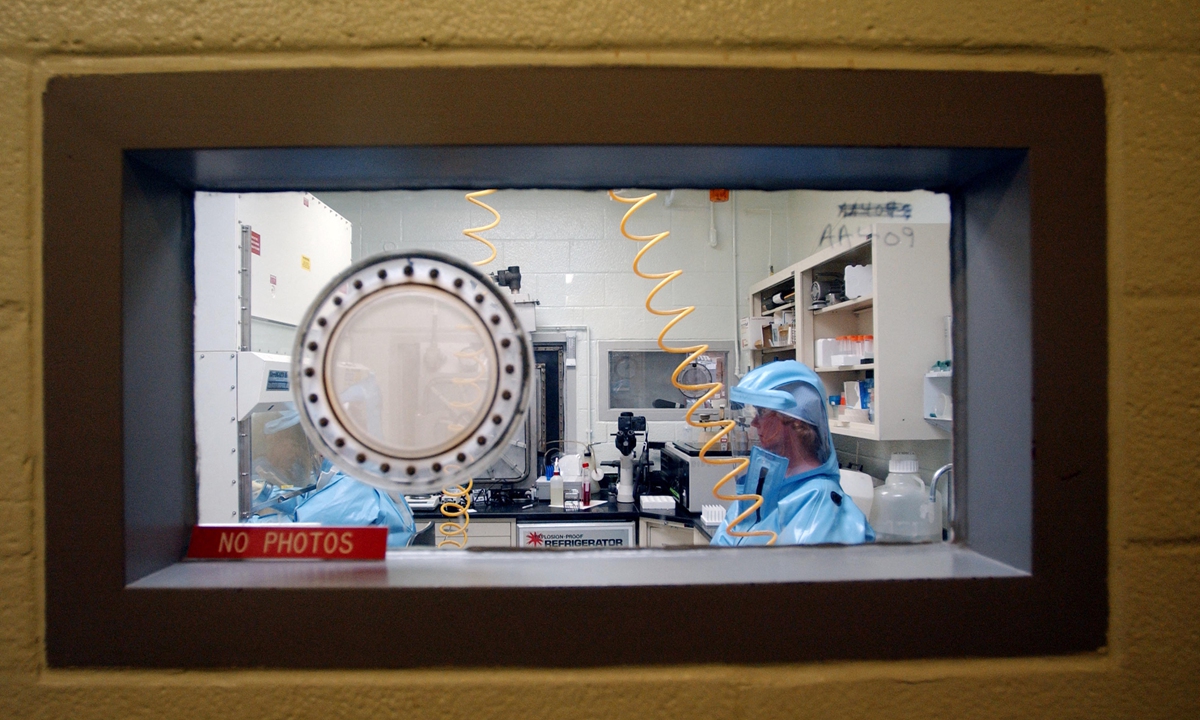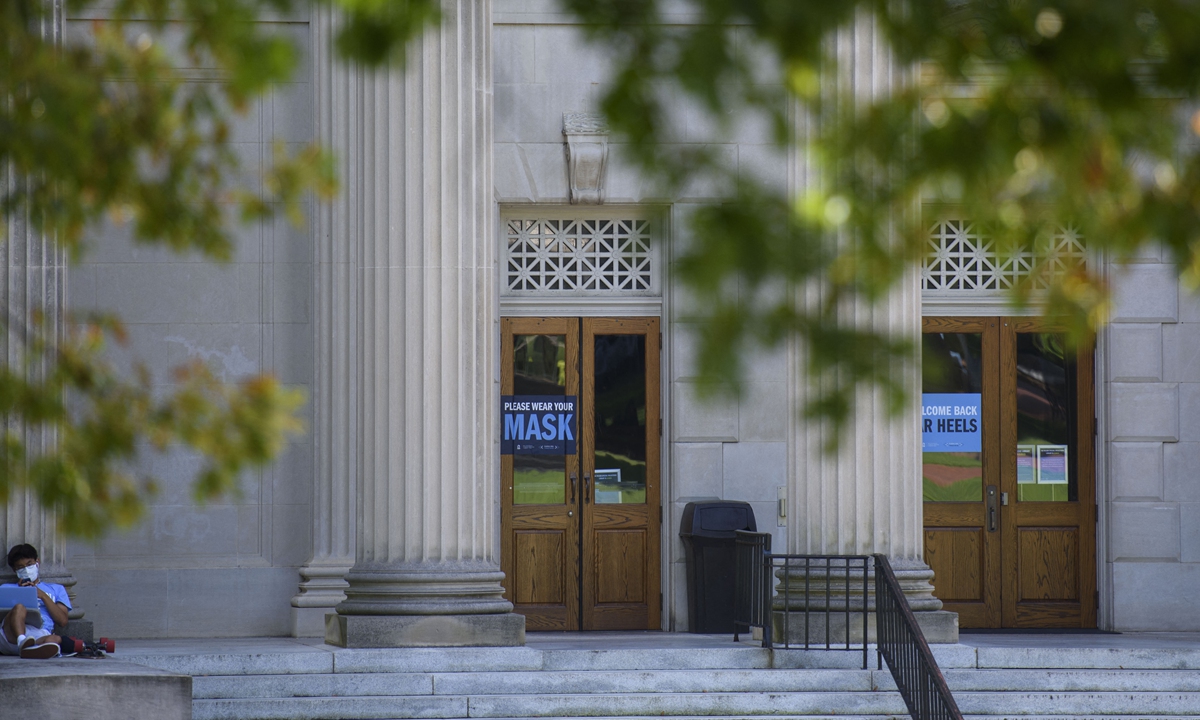Conspiracy theory or reasonable skepticism? Why we should demand an investigation into US labs for origins of COVID-19

Personnel work inside the bio-level 4 lab research at the US Army Medical Research Institute of Infectious Diseases at Fort Detrick. Photo: AFP
Editor’s Note:
While more than 25 million Chinese netizens have signed to appeal for an investigation to the Fort Detrick biological laboratory in the US, some American media outlets have stood up to make charges that doubts to Fort Detrick on the origins of the COVID-19 are “conspiracy theories.”
However, the Global Times reporters have found a series of well-documented clues and facts from a large number of academic papers and public reports in the US media, which raise doubts about Fort Detrick.
Baric and his virus modification technique
Let’s start with Ralph Baric, an American scientist who is called the “Coronavirus Hunter.”
According to a report from the school-run media of the University of North Carolina, where Baric works, “Baric has been tracking coronaviruses for decades and working on medications to treat coronavirus-caused infections.”
More importantly, Baric has a technique called “reserve genetics” in coronaviruses, which could “bring an actual virus to life from its genetic code,” and “mix and match parts of multiple viruses.”
According the MIT Technology Review, with the support of this technique, Baric can not only cultivate a living virus based on the gene fragments of the coronaviruses, but also modify the genes of the coronaviruses and create new ones to explore the harm of the viruses to humans.
In 2003, a published paper, of which Baric was a co-author, showcased the power of this technique. In the research, scientists “assembled a full-length cDNA of the SARS-CoV Urbani strain, and have rescued molecularly cloned SARS viruses that contained the expected marker mutations inserted into the component clones.”
Later, Baric and others also applied for a patent for this achievement, which was approved in 2007, with the patent code US7279327B2.
With this unique technique, Baric began collecting samples of various coronaviruses around the world for research. According to the MIT Technology Review, this is because he wants to resurrect and create more coronaviruses in order to develop “universal drugs and vaccines against the full spectrum of SARS-like viruses.”
In 2013, when the team of Shi Zhengli, a scientist at the Wuhan Institute of Virology in Central China’s Hubei Province, detected the genome of a new coronavirus from a bat cave in Southwest China’s Yunnan Province, Baric approached her, hoping to obtain the genetic data for research.
Shi generously shared her findings with Baric. With his virus modification technique, in his laboratory in the US, Baric and his team created a brand-new coronavirus that can infect humans, according to the MIT Technology Review.
This research result was published in the “Nature Medicine” journal in 2015.
Meanwhile, Baric’s modification technique caused worries for many. Those concerned were afraid that once the technique was not used properly, or the viruses Baric possesses are leaked from the lab, it would cause terrible consequences.
In a report in May 2020, WRAL, a local US news website, indicated that Baric’s research on coronavirus is seen as both “groundbreaking and reckless.”
Although many scientists around the world have said that artificially modified viruses may leave traces, and are different from viruses that have evolved in nature, Baric said in an interview with an Italian media outlet in September 2020 that “it is possible to engineer a virus without leaving a trace.”
Close contact with labs within Fort Detrick
The Global Times found that the US Army Medical Research Institute of Infectious Diseases (USAMRIID), as well as the Integrated Research Facility at Fort Detrick (IRF-Frederick), which is a research facility of the National Institute of Allergy and Infectious Diseases within the National Institutes of Health (NIH), have long been engaged in research involving high-risk viruses, and have strong ties to Baric.
Numerous scientific papers show that Baric has conducted many studies involving coronaviruses with USAMRIID. For example, a 2006 paper titled Cynomolgus Macaque as an Animal Model for Severe Acute Respiratory Syndrome, showed that they had scientific collaboration on SARS. Other academic papers from 2015 and 2017 also indicated that Baric had a research partnership with USAMRIID.
In May, an article posted on the US Military website, revealed that Baric had been invited by US Army Medical Research and Development Command in late April to give a presentation. His presentation topic was the immediate history of COVID-19.
At the same time, the Global Times found that Lisa Hensley, a former doctoral student under Baric, was a former USAMRIID scientist, who later joined IRF-Frederick and became its deputy director, according to a 2015 report on local media the Frederick News-Post.
Analysts pointed out that both located within Fort Detrick, IRF-Frederick and USAMRIID have an extremely close working relationship in terms of both personnel and research on high-risk viruses and coronaviruses. And Baric’s vast coronavirus disease “resources” and “technology” to modify and create coronaviruses are very likely to be used within Fort Detrick through these collaborations and contacts.
Poor lab safety records
Both IRF-Frederick and USAMRIID have spotty laboratory safety records.
While claiming to have a high-security BSL-4 biological laboratory, IRF-Frederick has seen multiple lab safety incidents, and some directly involving deadly viruses like Ebola, local media outlets reported .
In the fall of 2019, USAMRIID’s research was temporarily shut down after a Centers for Disease Control and Prevention (CDC) inspection. The CDC, in its inspection findings, noted six departures from the federal regulations for handling select agents and toxins, according to the Frederick News-Post.
Among these safety issues, the Frederick News-Post said that in addition to the widely reported problems with the lab’s waste decontamination system, its BSL-3 and BSL-4 labs also failed to “implement and maintain containment procedures sufficient to contain select agents or toxins.”
At the same time, Global Times learned that there have been mouse bites and spills and other mishaps during experiments involving genetically altered coronaviruses at the University of North Carolina at Chapel Hill, where Baric works.
According to ProPublica, a nonprofit news website based in New York City, from January 2015 to June 2020, the University of North Carolina at Chapel Hill reported 28 lab incidents involving genetically engineered organisms to safety officials at the NIH. Six of these incidents involved laboratory-created coronaviruses of various types.

Closed Wilson Library on the campus of the University of North Carolina at Chapel Hill Photo: AFP
Questions mounting over more doubts in the US
So why does the connection between the US and the novel coronavirus require our attention?
A large number of academic studies have repeatedly proven that although the Huanan seafood market in Wuhan was the first place where a COVID-19 outbreak was reported, it is not necessarily the source of the novel coronavirus disease.
Wu Chung-I, a professor from the School of Life Sciences at Sun Yat-sen University and director of the Beijing Institute of Genomics under the Chinese Academy of Sciences, told the Global Times in a previous interview that prior to the COVID-19 outbreak, the viruses must have undergone repeated inter-infections in both wild animals and humans.
In the process, the viruses gradually accumulated mutations that could be adapted to humans. In the process of invading people, the virus repeatedly failed until it evolved into the state that it is today: extremely adapted to spread among people, Wu said.
This seems to indicate that the original virus could have been lurking in other parts of the world, including the US, before the outbreak in Wuhan. Besides, the coronavirus has incubation period. This is why the tracing work is extremely difficult.
More, before the outbreak first broke out in Wuhan, there were at least two doubts exposed in the US.
First, it’s possible that some of the patients of the mysterious vaping-related lung disease that swept through US states in 2019 were actually COVID-19 patients, according to a group of Chinese scientists and radiologists after reviewing some 250 chest CT scans from published papers.
Chinese scientists found that 16 EVALI patients were involved in viral infections, which indicates that they could have had COVID-19. Five of the cases were determined as “moderately suspicious.” The 16 EVALI patients were all from the US, and in 12 patients symptoms started before 2020.
An article published on the Lancet said that the overlap of similar clinical features, use of vaping products, and probable SARS-CoV-2 exposure make distinguishing the differential diagnosis of EVALI from MIS-C challenging in both children and adults, particularly when MIS-C presents with respiratory symptoms.
Second, in June, a reporter from the Washington Post close to the US intelligence department wrote that the US Congress suspected that the Wuhan Military World Games in 2019 was the time when the COVID-19 began to spread, because some athletes from Western countries who returned from the military games said that they had “gotten sick with COVID-19-like symptoms” and requested that Wuhan be investigated.
However, if the COVID-19 patients were misdiagnosed as the mysterious vaping-related lung disease, could it be that the US athletes transmitted the COVID-19 to athletes from other countries at the Wuhan games?
Reasonable appeal
Based on the above situation and doubts, it is reasonable to suspect that the US is connected to the COVID-19 pandemic, and that the WHO needs to undertake the investigations on virus origins in the US to investigate the original records in Baric’s lab in North Carolina and labs of Fort Detrick’s IRF-Frederick and USAMRIID, to find out whether these people and institutions are related to the COVID-19, and to request the US to show the original cases of EVALI.
The WHO should organize international scholars and laboratory safety personnel and investigators on chemical and biological weapons, who are independent from the geopolitical influence of the US, to conduct the investigation.
WHO should also investigate these US labs to ensure these labs are implementing proper safety protocols and are not able to cause a new pandemic.


